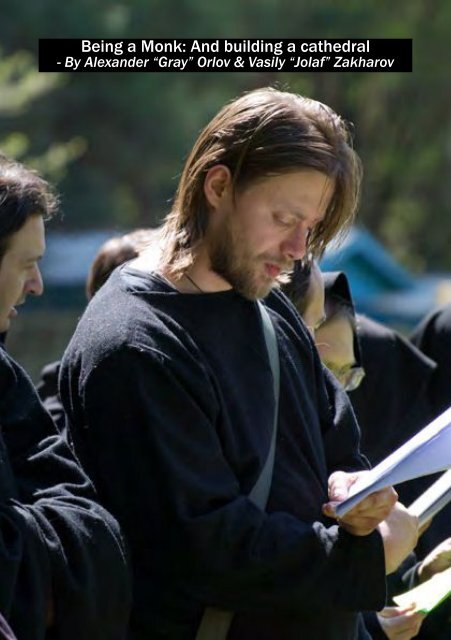nordiclarpyearbook2015
nordiclarpyearbook2015
nordiclarpyearbook2015
You also want an ePaper? Increase the reach of your titles
YUMPU automatically turns print PDFs into web optimized ePapers that Google loves.
Being a Monk: And building a cathedral<br />
- By Alexander “Gray” Orlov & Vasily “Jolaf” Zakharov<br />
Быть Монахом (Being а Monk) was a larp<br />
simulating the life of a Benedictine monastery<br />
in the Pyrenees during the Holy Week<br />
of 1202. The organizers were inspired not<br />
only by history and art, but also by their<br />
personal experience. The Duende larp held<br />
in 2010 in the Urals, where this larp’s organizers<br />
were players and part of the monastery<br />
team, proved that the life in a monastery<br />
could provide interesting play. Another<br />
source of inspiration was the experience<br />
of pilgrimage on the Spanish Way of Saint<br />
James (Camino de Santiago). Thus an idea<br />
of a larp about a monastery on a pilgrim<br />
route was born.<br />
Unity of place and time<br />
The core idea of the larp was to:<br />
Show the monastery structure as a hermetic<br />
microcosm;<br />
Make possible a unique and rich gameplay<br />
on religious subjects which are seldom<br />
touched;<br />
Make the monastery represent a moment in<br />
the history of the whole European religion;<br />
the Church’s decline and crisis at the beginning<br />
of the 13th century.<br />
The larp was focused on the idea of an<br />
individual within the structure, not on the<br />
structure itself – that is why the larp is titled<br />
Being a Monk, rather than, for instance,<br />
“The Monastery”. The Middle Ages were<br />
obsessed with the questions of essence and<br />
existence, and the existential aspect was<br />
crucial to the larp.<br />
g<br />
Why 1202? The idea of the Church on the<br />
edge of change was an important issue for<br />
us. The Franciscans and Dominicans were<br />
just about to appear, but their presence in<br />
the larp would make the answer too simple.<br />
The question was where the Western Christian<br />
world would go. Thus, the Benedictine<br />
monastery became the symbol of the<br />
Catholic Church, its inner problems – the<br />
distemper of all Christians, and the participants’<br />
answers defined the subsequent destiny<br />
of the Church.<br />
Why the Pyrenees? It was important that<br />
the monastery was situated on a pilgrimage<br />
route, and the Camino de Santiago was<br />
chosen. Vivid Basque culture created another<br />
plotline, throwing together Christians<br />
and pagans.<br />
j<br />
A rose is a rose is a rose is a<br />
rose<br />
The key sources of inspiration were Umberto<br />
Eco’s The Name of the Rose and<br />
Postscript to The Name of the Rose. However,<br />
the larp was based not on the books<br />
themselves, but on their sources, on the<br />
archetypal plots and conflicts. A monastery<br />
(though in another region than Eco’s), theological<br />
treatises, historical facts and legends,<br />
Benedictine regulations – it all formed the<br />
larp according to the spirit of the origin.<br />
102 103


